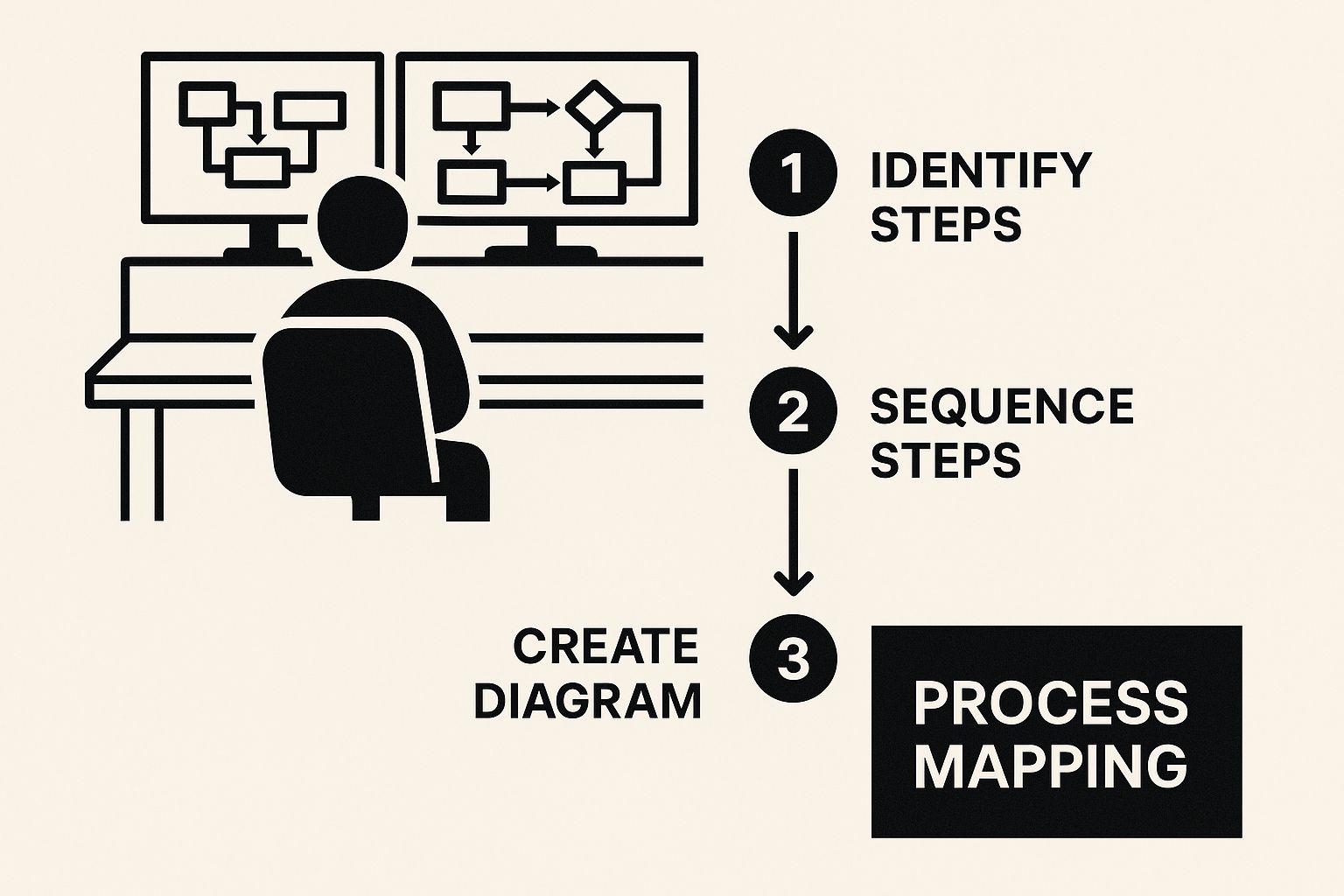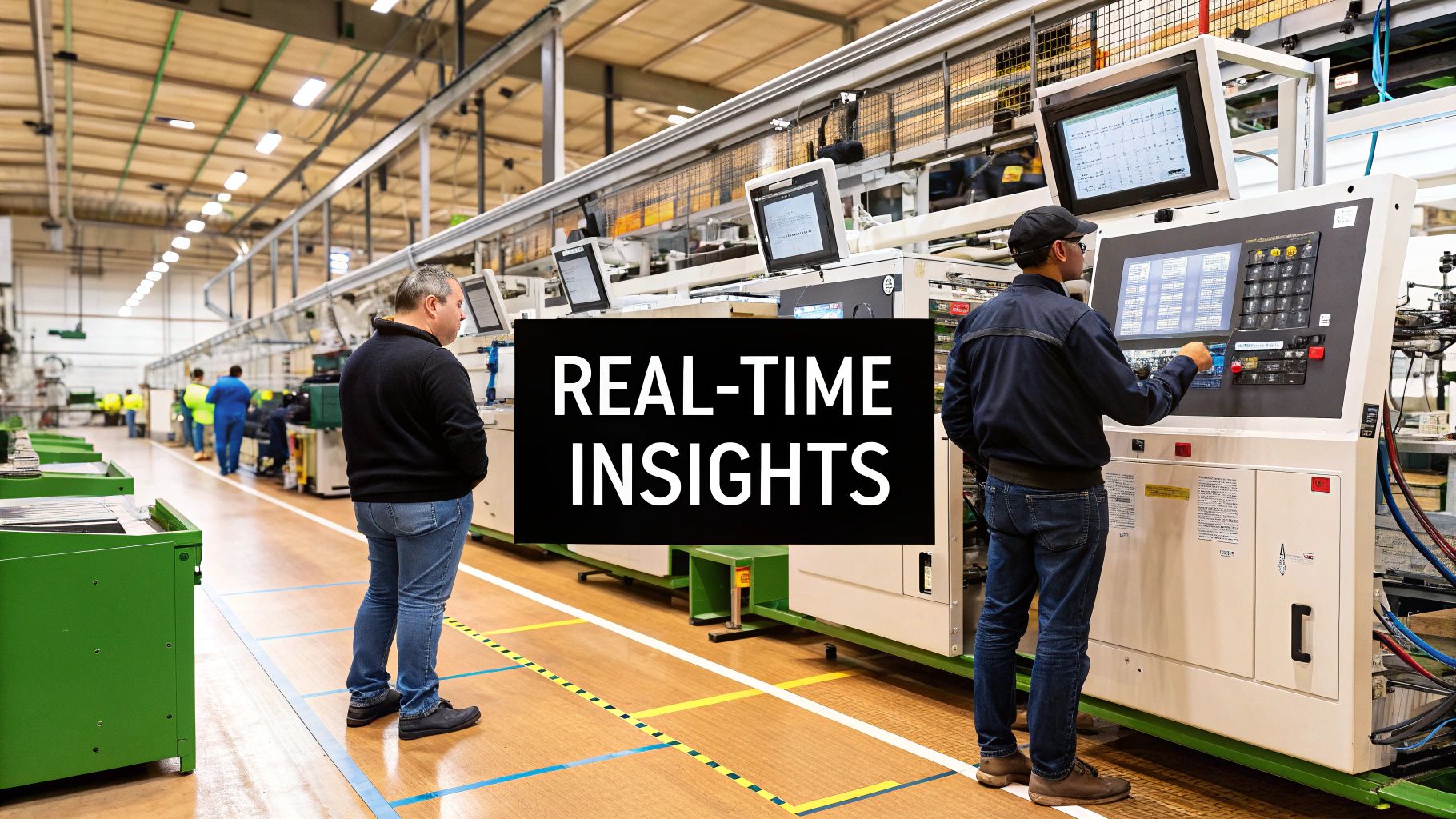What Is Process Mining Unlocking Business Insights
Think of process mining as an MRI for your business. Instead of relying on static flowcharts or what people think is happening, it gives you a dynamic, real-time picture of how work actually flows through your organization.
Your Business Processes Have a Hidden Story
Imagine you're trying to navigate a city using only the official subway map. That map shows you the planned routes—the clean, straight lines from Station A to Station B. But it tells you nothing about the daily reality: the unexpected train delays, the crowded platforms causing people to miss their connection, or the clever shortcuts commuters discover to save time.
Your official company handbooks and process documents are just like that subway map. They outline the ideal path. Process mining, on the other hand, shows you the actual, messy, and often surprising journey your work takes every single day.
Uncovering the Real Journey
Every action your team takes leaves a digital footprint in your software systems—your CRM, ERP, service desk, you name it. An invoice approval, a customer ticket update, a shipped order—each one is a timestamped event logged in a database somewhere.
Process mining tools connect to these systems, pull out millions of these digital breadcrumbs, and piece them together. The result? A living, breathing visual map of your end-to-end processes. Suddenly, you can see every single deviation, bottleneck, and workaround that you never knew existed.
This visualization shows you the flow of a typical process, highlighting the different paths taken and how often each step occurs.
What a map like this often reveals is that while a "standard" path exists, countless other loops and detours are happening constantly, pointing directly to rework and hidden inefficiencies.
Process mining replaces assumptions with facts. It's like getting an objective, data-driven X-ray of your organization's operational health. You can finally stop guessing and start diagnosing problems with surgical precision.
This shift toward data-driven improvement is why the market is exploding. The global process mining software market, recently valued at around USD 1.4 billion, is expected to skyrocket to USD 21.92 billion by 2030. That’s not just growth; it’s a clear signal that businesses are no longer willing to fly blind. You can dig deeper into this trend with data from Grand View Research.
How Process Mining Turns Data into Discovery
So, how does process mining actually work? It’s not about magic; it's a methodical, three-step journey that takes the raw, scattered data from your everyday operations and turns it into a crystal-clear picture of your business. This isn't about gut feelings or what you think is happening. It’s about seeing the truth hidden in your systems.
Think of it like this: every action in your company—an invoice paid, a ticket closed, an order shipped—leaves a digital footprint. Process mining gathers these footprints and connects the dots.

The image above gives you a great visual. It shows how those individual digital events are pieced together, step-by-step, to build a real-world map of your workflows, revealing every delay, detour, and deviation along the way.
The Three Core Types of Process Mining
At its heart, process mining can be broken down into three distinct but deeply connected disciplines. Each one answers a different, critical question about how your business runs, with each phase building on the insights of the last.
This simple breakdown helps clarify how process mining moves from simply seeing a process to actively improving it.
| Type of Process Mining | Core Question Answered | Primary Business Goal |
|---|---|---|
| Discovery | What is actually happening in our processes? | To create a 100% objective, data-driven map of the real process, free from assumptions. |
| Conformance | Are we following the rules we set for ourselves? | To compare the real process against the ideal model, instantly spotting compliance issues and deviations. |
| Enhancement | How can we make our process better? | To use the identified deviations and bottlenecks to diagnose root causes and drive tangible improvements. |
By moving through these stages, you ensure that every change you make is backed by hard evidence, not just intuition. Let's look at each one more closely.
Phase 1: Discovery
The first step, Discovery, is like sending a high-resolution drone to fly over your entire operational landscape. Its job is to map every single road, path, and shortcut your teams are actually using—not just the ones on the official map.
Process mining software does this by automatically pulling timestamped event data—those digital footprints—from your core IT systems like an ERP or CRM. It then stitches these events together to create a visual process graph. This isn't a flowchart someone sketched on a whiteboard; it’s the unvarnished truth of how work really gets done, complete with all the frustrating loops and unexpected detours your people navigate every day.
Phase 2: Conformance
Once you have this real-world map, you enter the Conformance checking phase. This is where you lay your "official" blueprint—your standard operating procedure or ideal workflow—directly over the drone footage you just captured. The comparison is immediate and revealing.
This overlay instantly highlights every discrepancy:
- Deviations: Where are people skipping mandatory steps?
- Violations: Are compliance rules, like approval limits, being ignored?
- Workarounds: What unofficial shortcuts have teams invented just to get the job done?
For instance, a conformance check might reveal that 17% of sales orders have their delivery dates changed after the customer confirmation has been sent. This single, non-compliant step could be doubling your order processing time without anyone even realizing it was the culprit.
Phase 3: Enhancement
Finally, armed with this powerful knowledge, you can move to the Enhancement phase. This is where insight sparks action. You no longer just know a bottleneck exists; you can dig into its root cause. Why are those delivery dates constantly being changed? Is it a systemic supply chain problem, a recurring data entry mistake, or a limitation in your ordering software?
The insights from conformance checking point you exactly where to focus. This ability to move beyond simple mapping is fundamentally changing how companies approach operational excellence. In fact, the market has shifted significantly. Process discovery once made up 38% of applications, but by 2022, enhancement was on track to hit 42% of all use cases. This shows a clear trend toward using these insights for active, data-driven improvement, a topic explored in depth by AIMultiple Research.
By identifying the "why" behind process deviations, the enhancement phase provides a data-backed roadmap for fixing inefficiencies, reducing costs, and ultimately creating a more resilient and effective organization.
The Real-World Benefits of Process Mining
It’s one thing to understand the mechanics of process mining, but the real magic happens when you see what it can do for your business. We're moving beyond the technical jargon to the real-world impact—the tangible, measurable results that directly boost your bottom line. This is all about swapping guesswork and gut feelings for a data-driven picture of reality, empowering you to make smarter, faster, and more profitable decisions.
This isn't just about finding a few small hiccups. It's about uncovering the deep-rooted, systemic problems that quietly bleed money and resources every single day. The improvements are felt everywhere, from the finance department to the customer support desk.
See Your Business With True Clarity
If there's one standout benefit of process mining, it’s the radical transparency it creates. For the first time, you can see how work actually gets done, not just how the old training manual says it should be done. This completely eliminates operational blind spots and puts an end to subjective arguments in meetings.
Instead of relying on stories about why a project is delayed, you can pinpoint the exact stage where the bottleneck is, how long it’s been there, and which teams are caught in the logjam. It gives everyone—from front-line staff to the C-suite—a single source of truth to rally around.
Unlock Serious Cost Savings
Hidden inefficiencies are silent profit killers. All that rework, those extra steps, and the little compliance slip-ups add up to a mountain of operational waste. Process mining shines a bright light on these dark corners.
For example, you might find that 25% of your invoices need manual fixing because of simple data entry mistakes, costing your team hours of extra work every week. Or maybe you'll see that a "maverick buying" habit is causing people to sidestep negotiated vendor discounts, costing the company thousands.
Process mining doesn't just find problems; it puts a price tag on them. It turns vague issues like "slow approvals" into concrete realities like "$50,000 lost annually due to payment delays," building an undeniable case for change.
Insights like these are exactly why so many are looking into this technology. While a staggering 93% of business leaders want to use process mining, a surprising 79% haven't started yet. That gap represents a huge opportunity. Meanwhile, 83% of those who have started plan to expand its use, a trend you can explore in more detail through the latest process mining trends. This tells you there's a major competitive edge waiting for companies that move now.
Create a Better Customer Experience
Let's be clear: your internal processes are your customer's experience. A clunky, slow order-to-cash cycle isn't just a cash flow problem—it means delayed shipments and unhappy customers. A messy customer support workflow means longer waits and tanking satisfaction scores.
Process mining lets you walk in your customer's shoes, using data to see what they feel. It helps answer the big questions:
- Where are customers stuck waiting the longest?
- Which process shortcuts are causing the most complaints?
- Are we actually hitting our Service Level Agreement (SLA) promises?
By smoothing out these internal bumps, you create a more fluid and dependable experience that builds real customer loyalty.
Nail Compliance and Manage Risk
In any regulated industry, following the rules isn't optional. But manual compliance audits are slow, expensive, and notoriously fallible. Process mining automates the entire thing.
The software continuously compares what’s really happening against your official compliance rules, instantly flagging every single deviation. This could be an invoice getting approved without the mandatory two signatures, or a customer data request skipping a required security check. You get a perfect, automated audit trail, making it incredibly simple to manage risk and satisfy regulators. For those looking to take the next step, our guide on the key benefits of business process automation is a great resource.
Process Mining Use Cases You Can Steal
Theory is one thing, but the real magic of process mining happens when you apply it to messy, real-world business problems. It's not about making pretty charts; it’s about untangling the knots that are costing you money and frustrating your teams.
Let's walk through a few common scenarios in B2B and SaaS to see how this works in practice. Each one follows a simple, powerful pattern: you start with a nagging problem, use process mining to uncover the real root cause, and then roll out a targeted fix. This is how you turn data into dollars.

Optimizing the Procure to Pay Cycle
The procure-to-pay (P2P) process is a classic headache for B2B companies. It’s a long chain of events—requisitions, POs, receipts, invoices, payments—and when it breaks, cash flow suffers, vendors get angry, and hidden costs pile up.
The Problem: A mid-sized manufacturer knew its cash flow was tight because its Days Payable Outstanding (DPO) was tanking. The finance team was putting out fires all day, chasing down approvals and calming down vendors with overdue invoices. They knew there was a blockage somewhere, but they couldn't see where.
The Discovery: They fed event logs from their ERP system into a process mining tool. The resulting visual map was an immediate eye-opener, revealing two massive bottlenecks:
- Endless Invoice Rework: A staggering 35% of all invoices were trapped in a back-and-forth loop between Accounts Payable and Procurement. The culprit? Mismatched purchase order numbers. Each time an invoice got stuck in this loop, it added an average of 8 days to the payment timeline.
- Rampant "Maverick Buying": The data also showed that 22% of purchases over $1,000 were happening outside the approved procurement system. These rogue purchases not only missed out on negotiated discounts but also created a nightmare of manual, after-the-fact approvals that brought the process to a crawl.
The Solution: With clear evidence in hand, the company took decisive action. They automated the three-way matching between POs, goods receipts, and invoices to flag errors in real-time. They also rolled out stricter spending controls and better training to curb the maverick buying. The result? They added 15 days back to their DPO in just six months.
Streamlining the Order to Cash Process
Just as critical as paying your own bills is getting paid by your customers. The order-to-cash (O2C) cycle is the lifeline of your business. Any friction here directly hits your revenue and your customer relationships.
The Problem: A B2B software distributor was dealing with a painfully long O2C cycle. The finger-pointing had already started: sales blamed the fulfillment team for being too slow, and fulfillment fired back that sales was sending them incomplete orders.
The Discovery: Process mining, pulling data from their CRM and order management system, settled the argument once and for all. It turns out, the fulfillment team was actually quite efficient. The real problem was that 40% of sales orders were having their delivery dates manually changed after the customer had already received a confirmation. This was because salespeople were skipping the initial credit check to close deals faster, forcing a downstream delay when the check was eventually run.
This is a perfect example of a hidden, non-compliant step causing a huge ripple effect. Without process mining, they would have kept trying to "fix" the wrong department.
The Solution: The company re-engineered its sales workflow. A credit check became a mandatory, automated step before any order confirmation could be generated. This one change eliminated the main source of delays, cutting their average order processing time by 30% and boosting their on-time delivery rate.
Enhancing SaaS User Onboarding
For any SaaS business, the first few days of a user's experience are make-or-break. If customers don't find that "aha!" moment quickly, they're gone. Process mining lets you see exactly where they get confused, stuck, or just give up.
The Problem: A project management SaaS startup was bleeding users during its 14-day free trial. They had standard product analytics, so they could see which pages users visited, but they couldn’t see the path that led good users to convert and frustrated users to churn.
The Discovery: They used process mining to analyze user event data from their app, mapping out the actual journeys every new user took. The insight was stunningly clear: users who failed to invite a team member within the first 48 hours were 80% more likely to abandon the trial. The process map showed these users clicking around the dashboard in a loop, seemingly lost and never finding the crucial "Invite Team" button.
The Solution: Armed with this insight, the product team made a tiny but powerful change. They added a simple, guided pop-up for all new users that prompted them to invite a collaborator as the very first step after creating a project. It worked. This one tweak increased their trial-to-paid conversion rate by 18%, proving that understanding the sequence of user actions is a game-changer.
Your Roadmap to Implementing Process Mining
So, you're ready to put process mining to work? Fantastic. Getting started isn't about flipping a switch overnight. Think of it as a focused journey that methodically turns your raw data into a real competitive edge. This is your practical, step-by-step playbook for getting it right.
The most important rule? Don't start with the technology. Start with the pain point.

Stage 1: Define Your Business Case and Scope
Before you even think about software, you need a crystal-clear answer to one question: what problem are we actually trying to solve?
A vague goal like "improving efficiency" is a ticket to a stalled project. You have to get specific. Are you trying to slash invoice processing times? Speed up the customer onboarding journey? Eliminate frustrating shipping delays?
Your goal must be something you can measure. For instance, "reduce the average order-to-cash cycle time by 15% within six months." A tight, focused scope makes your first project manageable and gives you a clear win to show for your efforts.
Stage 2: Assemble Your Implementation Team
Process mining is not an IT project. Let me say that again: it is not just an IT project. It’s a business initiative, and you need the right people in the room from day one for it to succeed.
Your core team should absolutely include:
- Process Owners: These are the managers and department heads who live and breathe this process daily. Their expertise is gold.
- Data Analysts: Your technical wizards who know the data structures inside and out and can figure out how to pull the event logs from your systems.
- IT Specialists: They’re crucial for getting secure access to systems like your ERP or CRM and managing the technical side of the process mining tool itself.
Bringing this group together ensures the data you pull actually lines up with the real-world business challenges you're tackling.
Stage 3: Identify and Extract Event Log Data
Now the real detective work begins. Your team needs to pinpoint which of your IT systems contain the digital footprints of the process you're investigating. For a procure-to-pay process, you'll likely be digging into your ERP. For a customer support issue, the ticketing platform is your treasure map.
Every event log you pull needs three essential ingredients:
- Case ID: A unique identifier that links all events in a single process instance together, like an invoice number or a customer ticket ID.
- Activity: The specific step that happened, such as "Invoice Approved" or "Ticket Escalated."
- Timestamp: The exact date and time the activity took place.
Getting this data right is everything. It's the foundation for your entire project. Remember: garbage in, garbage out.
Stage 4: Select the Right Process Mining Tool
The market for process mining software has exploded, with powerful options out there for different needs and budgets. North America currently leads the pack, holding about 32.93% of the market share, which means there's a healthy vendor landscape to choose from. You can get a deeper look into these market dynamics from Fortune Business Insights.
When you're looking at tools from vendors like Celonis or UiPath, think about ease of use (especially for non-technical business users), how well it connects to your data sources, and whether it has advanced features you might need later, like task mining or AI-driven root cause analysis.
The best tool isn't the one with the most features. It's the one that empowers your process owners to ask their own questions and find answers without needing a data scientist for every little thing.
Stage 5: Analyze Results and Create an Action Plan
Once your data is loaded and the tool works its magic, you get to the discovery phase. Your process map will instantly show you what's really happening—the "as-is" process, complete with every bottleneck, workaround, and deviation.
Use this visual evidence to build a concrete action plan. For every inefficiency you find, dig into the root cause and propose a specific fix. This is where insight turns into action, which is the whole point of any effort to streamline business processes.
Finally, don't treat this as a one-and-done project. The goal is to build a culture of continuous monitoring. Your process mining tool should become a permanent fixture, helping you track the impact of your changes and spot new opportunities as they pop up. This creates a powerful feedback loop for ongoing improvement.
The Future of Intelligent Process Automation
Process mining has always been fantastic for looking back and understanding what went wrong. But its real power is just starting to unfold as it combines with artificial intelligence, machine learning, and Robotic Process Automation (RPA). This combination is what will shift businesses from simply reacting to problems to actively preventing them.
Think about it. Right now, you might get a report telling you there was a massive bottleneck in your supply chain last week. What if, instead, a system could warn you about a potential bottleneck brewing for next week? That's the promise of predictive process monitoring, where AI uses live data to spot trouble long before it hits.
This is where process mining stops being just a diagnostic tool and starts becoming an active partner in running the business.
From Diagnosis to Autonomous Action
The next leap forward is even more impressive: autonomous optimization. In this model, the system doesn't just find and predict problems—it starts to fix them on its own. This isn't just a simple script; it’s an intelligent loop that combines several powerful capabilities.
- Automated Root Cause Analysis: AI algorithms don't just flag a symptom. They dig deep into the data to pinpoint the true "why" behind a potential failure.
- Data-Driven Recommendations: Based on the root cause, the system suggests concrete actions, like reallocating a team member or tweaking a specific workflow step.
- Triggering Automated Workflows: This is where the magic happens. These insights can automatically kick off other automations. To get a better handle on this, you can explore the basics of what workflow automation is and see how it connects disparate tools and tasks.
Let's say the system predicts an overload in the accounts payable team. It could automatically reroute less urgent invoices to another team or even deploy an RPA bot to take over routine data entry, freeing up the human experts to tackle the truly complex invoices.
This shift transforms process mining from a tool for analysis into an intelligent engine for continuous, automated business improvement. It's the key to building a truly agile and resilient organization that adapts in real-time.
The Rise of Specialized Intelligence
As the technology gets smarter, we’ll see it applied in more specialized ways. For a look at how AI is already changing specific financial roles, you can check out guides on tools like AI agents for accounting.
These focused AI agents, fed by the deep process understanding that mining provides, can manage incredibly specific tasks like compliance checks and fraud detection with an accuracy that humans struggle to match.
Ultimately, the future of process mining isn't just about getting a clearer picture of your business. It's about building a business that can see around corners, adapt on the fly, and constantly improve itself.
Common Questions About Process Mining
As leaders start to dig into process mining, a few questions always seem to pop up. Getting straight answers to these is key to seeing how this technology can actually work for your business, not just in theory.
Process Mining Versus Data Mining
What's the real difference here? Let's use an analogy. Think of data mining as a photograph of your business. It's fantastic for capturing a static moment and finding patterns in that snapshot—like identifying which customer segment was most profitable last quarter.
Process mining, on the other hand, is like watching a movie. It doesn't just look at a single moment; it follows the entire sequence of events over time. This lets you see the flow of how work actually gets done, revealing bottlenecks and hidden detours that a simple snapshot would completely miss.
Required Technical Skills
So, how technical do you need to be to get value from this? While getting the data pulled together for the first time usually needs some help from your IT team, modern process mining tools are built for business people, not coders.
The real magic of today's platforms is their user-friendly, low-code design. They're made for the process owners and business analysts who live and breathe these workflows every day—not just the data scientists.
This is a big deal because it puts the power to find and fix problems directly into the hands of the people who understand the process best.
Best Processes for Analysis
Which processes are the best fit for this kind of analysis? Process mining shines when you point it at structured, repeatable workflows that create a lot of digital footprints in your systems.
You're looking for high-volume, core operational processes. Good examples include:
- Order-to-Cash: Following every step an order takes from the moment it's placed until the payment is received.
- Procure-to-Pay: Mapping out the entire journey of a purchase, from request to final invoice payment.
- IT Service Management: Tracing a support ticket's life from the initial user report to its final resolution.
Basically, if you have a process that runs hundreds or thousands of times, leaving a trail in your software, it's a perfect candidate.
Ready to stop guessing and start seeing exactly how your business runs? The team at MakeAutomation specializes in helping B2B and SaaS companies implement data-driven automation to eliminate inefficiencies and scale growth. Discover how our tailored frameworks can optimize your operations.







